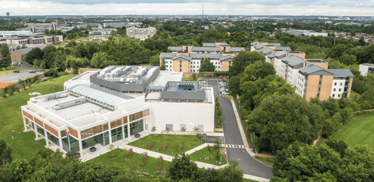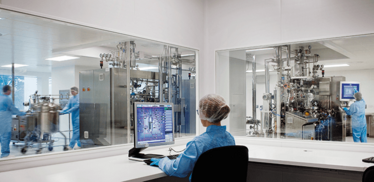
Finger on the Biopharma Pulse
When an industry grows rapidly, innovative approaches are required to ensure sustainable growth. Here, we speak to leaders at Ireland’s National Institute for Bioprocess Research and Training – NIBRT – to find out how a focus on talent, training and technology is changing the face of the field.
Finger on the Biopharma Pulse
Why is biopharma training so important?
In the ‘good old’ days, you finished your education, got hired, and learned on the job. But learning on the job isn’t always convenient in today’s fast-paced world, especially in a regulated and expensive industry. After all, mistakes in biopharma manufacturing can lead to the loss of an entire batch, equating to large losses in revenue. But if people aren’t allowed to fail, then how can they learn? Students typically learn how to be good students at schools, colleges and universities, but the practical side of bioprocessing is more challenging – and the reality is that students rarely leave higher education equipped with the complete skillset.

In Ireland, NIBRT is integrated into the curricula of various university programs to give students hands-on manufacturing experience. Biopharma manufacturing is a very controlled, logical and often repetitive process. Most people, with the right attitude, can be trained to work well in this environment. However not everyone is suited to working with GMP and a lot of people don’t like doing the same thing repetitively or working to such strict standards. Training also gives people the opportunity to see if bioprocessing is the right fit for them.
Would you say the industry is more open to graduates?
Being a graduate is not a prerequisite to being able to work in biopharma. I’ve seen people with no foundation at all still transition into various parts of the industry. Manufacturing is perhaps the most important area of the commercial biopharma industry. It can be overshadowed by research – but it is manufacturing that generates company revenues. There is often a shortage of skilled manufacturing personnel but it’s a job that many people can learn and be trained to do well. There is also a great career path in manufacturing. Most people will start on the production line, which is the best way to learn, but they can also transition to other specialized teams or subsets of the facility as they gain more insight – perhaps into validation, process design or approval roles, or into roles designed to better understand bioprocessing. With these more applied roles come wider responsibilities and not everyone is suited for this. They require a different skillset to what is needed on the manufacturing floor and you need people who can respond to problems and make good decisions – without panicking. Once you move into quality, you need to really understand the science and associated regulatory requirements. If you are the person in charge of releasing a product then you could be the one going to jail if there’s a problem!
What are the main drivers in biopharma manufacturing?
In its Process Analytical Technology Guidance released in 2004, the FDA introduced a concept that we’ve all become very familiar with today: Quality by Design (QbD). QbD has focused the industry’s attention on process improvements, such as getting more product from process, resulting in lower costs and more predictable production. This is important because cost is a huge issue in biopharma production. Simply maintaining your license and keeping the operation going is a huge investment.
You can’t always change the steps needed for biopharma production, but you can make them more efficient, such as by using smaller or more flexible equipment, or replacing stainless steel with single-use components. Even a small change can have a beneficial impact. When you’re manufacturing a product in a bioreactor, you’re actually making several versions of that product. There can be a lot of wastage and the industry has not quite figured out how to manipulate the cells to generate the one true product that is wanted. If you could make the cells make more of your product by even just 20 percent, it would save 20 percent of facility time per annum. The saved resources could be used to manufacture another product, which is important because another problem facing the biopharma industry is factory floor space. A lot of exciting biopharma products are coming down the pipeline, but where are they going to be made? Perhaps companies will come to Ireland to build increased capacity in a new facility, which addresses one issue, but a facility quickly gets busy. I think the increased use of modular facilities is definitely one way to go.
Is there any danger that a new facility may be out of date before it even opens?
Building a new facility certainly takes time and money, and designers have to base their plans on today’s certainties rather than tomorrow’s uncertainties. However, it’s easy to invest millions of dollars into a fantastic looking facility that is then not fit for purpose in 10 years’ time because the processes of the future are likely to be much smaller in scale. Right now, companies often need big manufacturing facilities because they have large patient bases for high dose products and there’s no getting around that. Smaller manufacturers have an edge because they can take advantage of new smaller flexible systems – like single-use bioreactors – because they don’t have to deal with the same volumes that big manufacturers have to contend with.
When designing a new facility, you have to consider potential demand. At the very start of production for a new drug, you may not immediately need huge bioreactors, but the initial decision is often made to invest in stainless steel because later demand is expected. Once you start producing and selling the drug, you can quickly make your investment back (assuming all goes to plan). Stainless steel is well proven and understood, but does it make for the most versatile, flexible plant?
Another problem for big companies is that there is often much competition. For example, Regeneron is building a large manufacturing facility in Ireland to scale up a drug that received FDA approval last year (Alirocumab – developed with Sanofi). It’s a PCSK9 inhibitor designed to treat high cholesterol in adults. Immediately afterwards, Amgen received approval for their own PCSK9 inhibitor – Evolocumab – and Pfizer is also developing a similar product – Bococizumab – which hasn’t yet been approved. Few companies are in the fortunate position of serving a patient base that no one else serves, so there’s a constant race to market and battle for market share.
How can we battle the high costs of biopharma?
Pharma is a very attritional business. Just look at therapeutic monoclonal antibodies – we’ve had the technology in place for making them for over 40 years and yet less than forty molecules have gained regulatory approval.
Single-use technology is promising because of its potential to cut costs. You can build a operational large scale stainless steel plant for $500 million in around three to four years, but with new advances in single-use technology, you can build a facility with a potentially similar throughput (depending on how big your volumes need to be) in around two years at probably a fifth of the cost – which can get your product to the market faster. In spite of the many advantages, however, single use technologies are not without their challenges. Extractables and leachables from the plastic films are one concern and there is also the issue of available scaled systems. Would you really want to use a 10,000-liter single-use bag, even if one was available? Single use is also an ongoing consumable – and the costs can rack up. Manufacturers using single-use manufacturing strategies are also more dependent on their vendors and the wider supply chain in a way that hasn’t been seen before. If a bioreactor bag comprises various components, which all come from different vendors, you’re not relying on one vendor, but a whole network.
That said, there are challenges with stainless steel too, albeit we have a longer manufacturing history with these systems. Contamination can be an issue and the fact that you have to do the cleaning at all is a disadvantage in terms of clean utilities, time and talent – your workers are going to spend large portions of their time cleaning and turning around equipment between batches.
Any predictions for the future of biopharma manufacturing?
I heard an interesting prediction from someone recently – and I’ll repeat it here. In 10 years’ time, just looking at the production bioreactor as an example, the industry will probably be using 50/50 plastic/stainless steel. In 50 years’ time, very few manufacturers may be using stainless steel. Biopharmaceutical molecules are often very challenging to manufacture and purify – and in 50 years’ time they will still be challenging. We can collapse the required footprint, but cells will always be cells. There are some really interesting ideas about biopharma manufacturing being researched. For example, Thermo Fisher Scientific, the University of Maryland, Baltimore Country, Ohio State University and Latham Biopharm are collaborating to make biopharma medicines on demand. The grand aim is to be able to create medicines on battlefields for wounded soldiers, in remote locations, or in response to medical emergencies. The idea of moving away from being dependent on one large facility and instead bringing shipping and manufacture closer to the patient is something that is gaining increased attention across the entire pharma industry, particularly as we move towards personalized medicine, which will no doubt require regional centers. Greater utilization of continuous processing strategies are attracting wide interest due to their potential for improving the productivity of a process and reducing the facility footprint.
Is the hype around personalized medicine and cell therapy valid?
Earlier this year, there was a lot of media attention around T-cells after researchers claimed to have seen some extraordinary responses in patients with acute lymphoblastic leukaemia. Using the body’s own immune system to fight cancer is very clever, but there is still much research to do. The technique the researchers were using was taking a patient’s own T-cells, re-energizing them and then putting them back into the patient. How do you scale that up and perform cell therapy on a commercial basis? I think we’re some way off seeing personalized therapy manufacture, perhaps it will be done in hospitals rather than manufacturing plants as we know them. While welcoming and embracing the potential of such therapies, we also need to be realistic. As an example, think about all of the hype we’ve heard about gene therapies over the years, but although thousands of clinical trials have been conducted, only a very small number of licenses have been granted.
Train and Retain
By Killian O’Driscoll, Projects Director at NIBRT
Believe in Bioinformatics
With Colin Clarke, Principal Investigator at NIBRT
Know Your Process, Know Your Product
With Jonathan Bones, Principal Investigator at NIBRT























